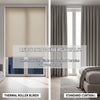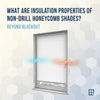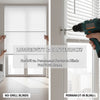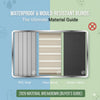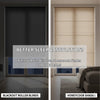A Complete Safety Checklist for Choosing Blinds in Family Homes
- by Mariam Labadze
Quick Answer
Family-safe window blinds prioritize cordless operation eliminating strangulation hazards, secure mounting preventing falls, non-toxic materials avoiding harmful chemical exposure, and child-resistant mechanisms stopping dangerous tampering. UK regulations mandate cordless or approved safety devices for homes with children under 42 months. Essential safety features include: breakaway cords (if corded), tension devices preventing loop formation, secure bracket installation supporting weight without pulling loose, flame-retardant materials meeting safety standards, and wand controls replacing dangerous cords. Avoid corded blinds near cribs or play areas, treatments with small detachable parts creating choking hazards, or products lacking current safety certifications. Professional installation ensures proper securing and operation, whilst regular safety inspections identify developing hazards before accidents occur.
Legal Requirements and Standards
UK Safety Regulations – Current UK law requires window coverings in homes with children under 42 months featuring either completely cordless operation or approved safety devices preventing dangerous cord loops forming. These mandatory standards apply to new purchases and existing installations, making compliance legal obligations rather than optional safety suggestions.
Landlords bear particular responsibility ensuring rental properties meet safety standards. Failure providing compliant window treatments creates liability if accidents occur, making cordless systems essential investments protecting both tenants and property owners from tragic consequences and legal ramifications.
EN 13120 Standard – This European safety standard specifies requirements for internal blinds including cord safety, operational force limits, and durability testing. Products meeting EN 13120 demonstrate compliance with comprehensive safety criteria covering multiple hazard types beyond purely cord-related concerns.
Verification that products meet EN 13120 or equivalent standards provides assurance that independent testing confirmed safety features perform as claimed rather than relying purely on manufacturer assertions lacking third-party validation.
Building Regulations – New construction and significant renovations must incorporate window treatments meeting current safety standards. Architects, builders, and developers must specify appropriate products ensuring compliance rather than defaulting to whatever proves cheapest or most readily available without safety consideration.
Cordless Systems: The Gold Standard
Spring-Loaded Mechanisms – Modern cordless roller blinds use sophisticated spring systems allowing easy operation through gentle pulls on bottom rails. When pulled downward slightly, springs engage holding desired positions when released. These mechanisms eliminate all hanging cords whilst providing reliable functionality that children and adults operate equally easily.
Quality spring systems operate smoothly for years without adjustment, though occasional tension modifications might prove necessary as springs gradually relax over time. This minor maintenance proves trivial compared to the absolute safety cordless operation provides.
Motorized Solutions – Completely eliminating manual operation, motorized blinds represent ultimate safety through removing all physical controls that children might access or manipulate dangerously. Remote controls, smartphone apps, or voice commands manage all positioning, ensuring zero strangulation or entanglement risks.
Battery-powered motors provide cordless convenience without electrical installation complexity, whilst hardwired systems eliminate battery maintenance concerns. Both approaches deliver equivalent safety benefits, with selection depending on installation preferences and ongoing maintenance willingness.
Perfect Fit Systems – These innovative clip-on frames attach to uPVC window beading without drilling, featuring blinds operating within frames that move with windows when opened. The complete absence of cords, chains, or hanging mechanisms makes Perfect Fit inherently child-safe whilst providing practical benefits for tilt-and-turn windows common in modern UK construction.
Safe Corded Alternatives (When Necessary)
Wand Controls – Solid rigid wands replacing flexible cords on some vertical and roller blinds provide manual operation without creating dangerous loops. The wand's rigidity prevents neck entanglement whilst the attachment point typically positions high enough preventing young children reaching independently.
Wand controls represent reasonable compromises when motorization proves cost-prohibitive and spring cordless mechanisms don't suit specific blind types. However, truly cordless or motorized options remain preferable when accessible.
Breakaway Safety Features – Some modern corded systems incorporate breakaway connectors that separate under modest pressure if children become entangled. This potentially life-saving feature provides protection when eliminating cords entirely proves impractical, though prevention through cordless design remains superior to relying on breakaway mechanisms functioning correctly during emergencies.
Tension Devices and Cord Cleats – When corded blinds prove unavoidable, tension devices mounted to walls keep cords taut whilst cord cleats provide secure wrapping points preventing dangerous loops forming. These retrofit safety additions improve existing installations but don't eliminate hazards completely—they reduce rather than remove risks.
Position tension devices ensuring cords remain taut and inaccessible to children under all circumstances. Regular inspections verify continued effectiveness as devices can loosen over time through repeated cord movement and tension cycling.
Installation Safety
Secure Mounting – Properly installed blinds must withstand reasonable pulling forces without brackets pulling loose or products falling. This proves particularly important for families with young children who naturally pull, climb, and test everything within reach during developmental exploration.
Use appropriate fixings for wall construction—long screws into studs for plasterboard, suitable wall plugs for masonry, and adequate fasteners for uPVC frames. Under-specified fixings create fall hazards when blinds become unintentional climbing aids during play or curious investigation.
Height Considerations – Mount cordless blinds at heights allowing adult operation whilst preventing children reaching bottom rails where mechanisms control operation. This proves particularly relevant for bottom-up treatments or those where child access might create operational problems or minor finger-pinching injuries.
Clearance from Furniture – Position blinds ensuring operating mechanisms don't contact cribs, beds, or furniture that children use for climbing. Accessible cords or controls near elevated surfaces where children play or sleep create dangerous opportunities for entanglement that thoughtful positioning prevents.
Regularly reassess safety as children grow and abilities change. Treatments perfectly safe for infants might become accessible hazards as toddlers develop climbing skills and curiosity about mechanisms previously beyond reach.
Material Safety
Non-Toxic Compositions – Avoid products containing harmful chemicals including formaldehyde in adhesives, lead in components, or toxic flame retardants that off-gas into indoor air. OEKO-TEX certification for fabrics or GREENGUARD certification for complete products verifies testing confirmed minimal VOC emissions and harmful substance absence.
Cheaply manufactured imports sometimes contain problematic materials that European manufacturing standards prohibit. This hidden danger proves particularly concerning for children's rooms where air quality significantly impacts developing bodies more sensitive to chemical exposures than adults.
Flame Retardancy – UK regulations require window treatments meeting fire safety standards, particularly in rental properties and escape routes. However, achieving fire resistance shouldn't involve toxic chemical treatments that create different health hazards.
Natural wool provides inherent flame resistance without chemical treatments, making wool-blend fabrics excellent choices balancing fire safety with chemical avoidance. Some modern synthetic fibers possess built-in flame resistance eliminating separate chemical treatment requirements.
Choking Hazard Prevention – Avoid blinds with small detachable parts—decorative elements, loose hardware, or poorly secured components—that might detach becoming choking hazards for young children who explore everything orally during early development stages.
Regularly inspect blinds ensuring all components remain secure without loosening that might allow small parts separating during normal use or rough handling that children inevitably provide.
Age-Appropriate Safety Considerations
Infants (0-12 Months) – Young babies require complete cord elimination in any rooms they occupy. Mount blinds securely preventing any possibility of products falling into cribs or play areas. Cordless blackout options support healthy sleep whilst providing absolute safety during vulnerable early development.
Toddlers (1-3 Years) – This age presents maximum risk through climbing abilities combined with insufficient judgment recognizing dangers. Cordless systems prove absolutely essential, with additional considerations including preventing access to operating mechanisms that curious toddlers might manipulate creating operational problems or minor injuries.
Young Children (3-8 Years) – Whilst direct strangulation risks decline somewhat, proper safety features remain important. Children this age explore homes independently and might access blinds in various rooms requiring consistent cordless approaches throughout properties rather than limited deployment in obvious nursery/bedroom locations.
Older Children and Teens – Safety focus shifts toward ensuring blinds remain functional and properly maintained rather than preventing direct injury. However, maintaining cordless consistency proves valuable through preventing younger visiting children—cousins, friends' siblings—encountering hazards in homes that family ages beyond direct risk.
Ongoing Safety Maintenance
Regular Inspections – Monthly safety checks verify that brackets remain secure, cordless mechanisms operate smoothly, and no new hazards developed through wear or damage. This proactive approach identifies problems before failures create dangerous situations.
Examine mounting brackets ensuring screws remain tight, check cordless springs maintain proper tension, verify motorized systems respond reliably to commands, and confirm no loose parts developed through normal operational wear.
Immediate Repairs – Address any damage immediately rather than postponing fixes. Broken components might create new hazards—sharp edges, unstable structures, exposed mechanisms—that weren't present when products functioned correctly. Prompt repairs prevent minor damage escalating into significant safety concerns.
Replacement Timing – When blinds reach end-of-life through age, damage, or mechanical failure, prioritize safety during replacement selection. This proves particularly important when children's ages have changed since original installation—ensure replacement products address current household composition rather than outdated situations.
Room-Specific Safety Guidelines
Nurseries – Absolutely require cordless operation, secure mounting preventing any fall possibilities, non-toxic materials avoiding chemical exposure, and blackout capabilities supporting healthy infant sleep patterns. No compromises prove acceptable in spaces where vulnerable babies spend substantial unsupervised time.
Children's Bedrooms – Maintain cordless standards whilst considering age-appropriate designs and colors. As children grow, involve them in selection processes teaching aesthetic decision-making whilst adults ensure safety remains uncompromised regardless of style preferences.
Playrooms – High-activity spaces demand particularly robust installations withstanding rough play including accidental impacts from toys or energetic children. Cordless operation prevents entanglement during active play whilst secure mounting prevents blinds becoming unintended climbing structures.
Bathrooms – Moisture-resistant cordless options provide safety whilst withstanding humid conditions. Consider that bathrooms often contain stools, toilets, or furniture children use accessing elevated positions, requiring blinds positioned preventing dangerous access even when children stand on fixtures.
At 1 Click Blinds, child safety represents our paramount concern when helping families select window treatments. Our comprehensive cordless range, safety-focused consultation, and commitment to current safety standards ensure UK families find solutions protecting their children whilst enhancing homes beautifully and functionally for years of worry-free daily life.

